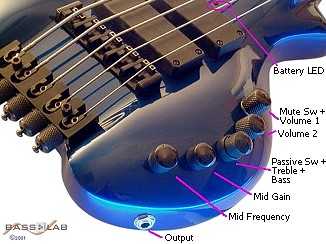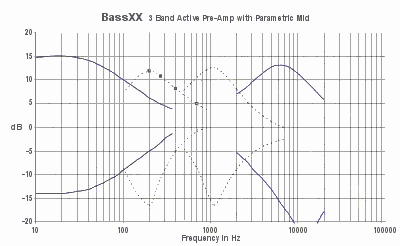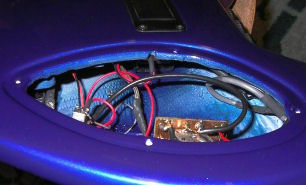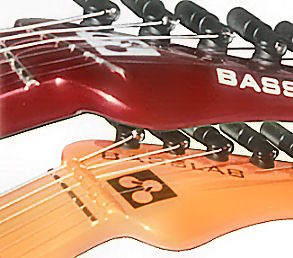Technical Details
 Most people feel that the BassXX preamp
(pronounced like basics)
is the most musically useful preamp they ever have used.
The preamp has an extremely low noise floor and tube-like dynamic response, but has no discernable hiss even at extreme high-frequency boosting.
The natural sound of the preamp is warm, full and clear.
Because the input impedance is high, passive pickups retain their natural frequency response and tonal character.
Rather than being a volume booster, the BassXX is a filter-based pre-amp which provides very flexible parametric EQ control with sweepable mid and asymmetric responses.
Most people feel that the BassXX preamp
(pronounced like basics)
is the most musically useful preamp they ever have used.
The preamp has an extremely low noise floor and tube-like dynamic response, but has no discernable hiss even at extreme high-frequency boosting.
The natural sound of the preamp is warm, full and clear.
Because the input impedance is high, passive pickups retain their natural frequency response and tonal character.
Rather than being a volume booster, the BassXX is a filter-based pre-amp which provides very flexible parametric EQ control with sweepable mid and asymmetric responses.
To the left is a close-up of the BassXX controls on an L-BOW-V with two pickups. This particular instrument is configured with two volume controls - one for each pickup - but it could have been a master volume and blend. In fact, any volume control arrangement is possible on a BassLab instrument. The volume controls come before the preamp, so the choice is yours.
On this instrument, the first (neck) volume control pulls up to mute the instrument, by disconnecting the pickups from the input of the preamp. This is a very handy feature in between sets.
| BassXX Specifications | |
| Input Impedance | >500kOhm |
| Output Impedance | <100kOhm |
| Voltage | 9V (18V by request) |
| Current Draw | 0.6mA (~900 hours) |
| Construction | FET op-amp, mini-SMD |
| Controls | Center detent 100k linear 250k for volumes |
| Bass | ±14dB at 20Hz |
| Mid | +12dB and -16dB sweep 200Hz - 1100Hz |
| Treble | +13dB at 6kHz -25dB at 12kHz |
Since the BassXX is a filter-based preamp, you can bypass the preamp and go into passive mode. This is accomplished by pulling up on the treble knob. The passive sound is virtually identical to the active sound in tone and level if the EQ is set flat. In passive mode, only the volume controls function, but passive tone control can be added on custom instruments. Nevertheless, a wide variety of sounds are possible by mixing the two or more pickups, and your instrument can also include series-parallel or single-coil options.
The mid control on the BassXX is very powerful. By sweeping the frequency with the gain turned up, you can achieve a strong wah-wah effect. On this instrument, the mid frequency and mid gain are separate knobs, but a single stacked knob is the current configuration.
The battery charge control LED flashes when approximately 2 hours of clean
power remains.

Heiko Hoepfinger designed the BassXX preamp circuit to match the tonal characteristics of his "Tunable Mixed Composite" material. Richter Electronics of Germany builds the preamps for BassLab.
The frequency chart shows some interesting features of the BassXX. Most visible is that the treble control is "asymmetric", which means that the center frequency when cutting is different from the center frequency when boosting. Also, the cut amount is greater than the boost amount. This, along with the wide-ranging sweepable mid (which has a narrower Q when cutting than boosting) and the clean bottom end, gives the preamp it's musicality.
We've built a preamp into a small box, so players try it out with their own instruments. Stew McKinsey, a well-known player in the world of extended-range bass, says:

The preamp arrived at my place a few weeks before the last BOG (Brotherhood of Groove) tour and I never had a chance to get my thoughts in print and up onto the 'net. Please forgive me for hogging this li'l piece of dynamite for so long. Here are my thoughts on it...
The BassXX preamp is a really nice circuit. It actually manages to cut and boost the chosen frequency ranges without coloring the tone of your axe! More than that, it is clean and quiet.
As most everyone knows, I am Captain Low Tech and the champion of instruments with no knobs or switches, so I was surprised when Greg asked me if I would take a look at the box and give it the once-over.
I was really impressed!
I'm not looking to go active on my basses, but this not only reminded me how fun toys are, it also brought back how handy an active circuit can be for studio work. I think one of the reasons I started moving toward fully passive basses is because active electronics give me the ability to sound like so many other players and I wanted to sound like me!
Now that technology like this exists, I may rethink some of my rationale...
The preamp can be purchased separately, with or without volume pots and knobs, for installation in most basses. The folks at Windmill Guitars say it's "the most quiet active electronic in the world!" Thanks guys!
You can find out more about the BassXX at www.bassxx.de.
 BassLab instruments feature a specially-angled bridge and tailpiece, to balance the attack and sustain of the tone from string to string.
The photo shows that the bass-side of the tailpiece (on the left) is lower than the treble-side.
BassLab instruments feature a specially-angled bridge and tailpiece, to balance the attack and sustain of the tone from string to string.
The photo shows that the bass-side of the tailpiece (on the left) is lower than the treble-side.
This is based on the principle that the break angle of the string over the bridge influences the ratio between attack and sustain. A sharper break angle applies more pressure on the bridge, resulting in the tone developing faster but at the expense of sustain.
It's true that all strings should have as much sustain as possible, but it's also important to achieve a quick attack in the development of the tone. And a quick attack is especially important for the lower notes.
In other words:
Higher strings will naturally achieve full tone faster (because of the lower inertia of the lighter strings),
so they can have a smaller break angle, resulting in good sustain.
Lower strings will naturally bloom slower, requiring a sharper break angle to accelerate the attack.
Conveniently, the greater string mass of the lower strings tends to compensate for the slight loss in sustain
(because the greater inertia tends to keep the string vibrating longer).
 BassLab instruments are completely hollow inside!
The Tunable Mixed Composite material plus graphite cloth provides the strength to support the outer skin,
which is generally about 4mm thick.
That's just a bit thicker than the surface of an acoustic guitar.
BassLab instruments are completely hollow inside!
The Tunable Mixed Composite material plus graphite cloth provides the strength to support the outer skin,
which is generally about 4mm thick.
That's just a bit thicker than the surface of an acoustic guitar.
The BassLab Composite is unique because it is not made primarily of graphite like other composites. It is specifically formulated for its tonal properties, using a variety of "secret" ingredients. For more on the musical benefits of the Composite, see our report on Tunable Mixed Composite vs Wood. Because of the single-piece hollow body shell, there is electrical shielding throughout the entire instrument, not just around the electronics cavity.
The photo shows the back of an STD-V bass with the electronics cover removed. At the top of the image, you can also see the black cover of the flip-up battery compartment. Part of the compartment itself is barely visible inside the instrument.
On the far left, just visible inside the opening, is the blue-painted block that one end of the bridge pickup screws into. To the right of that is the volume control and mute switch for the first pickup. The second volume control is not visible, although you can see the braided wire from the pickup (with shrink wrap on the lower end).

The shiny black wire carries the signal from the mute switch to the copper-clad BassXX circuit board. The board itself is attached to the stacked treble-bass control. The thick silver wire leads to the output jack, although it loops a bit in this instrument.
The image on the right was taken with a small (and not very good) webcam, which was placed inside the body. The back of the instrument is at the top of the photo. You can see the two pickup mounting blocks at the top, the two black pickups at the bottom, and the braided wire running to the neck pickup.
Unlike an acoustic guitar, there are no internal braces for support or to control vibrations. But, like a classical upright bass, some BassLab models have a "tone post" which joins the front surface to the back surface under the bridge. Of course, certain areas of the BassLab shell are thickened to provide support for hardware.
The BassLab Composite gives us the freedom to shape the instruments any way we need to. We don't do this just to make them look a certain way. In fact, the sound is the most important thing, so sound determines the shape. For example, the STD model is essentially an "arch-top", which controls the range of resonant frequencies. Also, the lower horn curves inwards and restricts the movement of the front surface, kind of like putting your hand on a drum skin.
A secondary goal is ergonomics, or how it feels to hold the instrument. The STD model in particular is designed for playing comfort, with the upper horn curved to place the neck forward and upward:

Now do you see what ergonomics really means?
The Rough Crystal pickups are hand-made by Reiner Dobbratz and his team at Le Fay, and are popular with many German luthiers. Heiko Hoepfinger has known Reiner for a number of years. The pickups are a great match for BassLab electric basses. Heiko uses them in both active and passive mode, where the output level is the same whether the preamp is on or off.
The "stacked single coil humbucking" pickups are actually two coils, one on top of the other. They are wired so that hum is cancelled, hence the name humbucking. These narrow pickups capture vibrations from a small area of the vibrating string, resulting in a pure, focused tone.
The "soapbar" pickups are also humbucking pickups, but the two internal coils are placed side-by-side. This arrangement captures string motion from a larger area of the vibrating string, giving a more complex harmonic mixture. The sound could be described as more aggressive, but that depends on what you play!
 Since BassLab instruments are hand built, you can choose from many different details.
Since BassLab instruments are hand built, you can choose from many different details.
Earlier guitar models (like the orange one pictured here) used a raised ridge of the composite material as the nut. This worked very well, although it was harder to level the zero fret during final setup.
More recent guitars, like the red one, use an angled fret with deep notches. This method is interesting because it matches the extra fret that is often included at the other end of the neck.
Another option, not shown here, is a separate machined metal nut that is screwed on. The benefit of this is that it can be replaced later to achieve a different string spacing. And, of course, it makes it easier to dress the frets!
In this image, you can also see the LSR tuners.
 BassLab has just developed a new finish effect!
BassLab has just developed a new finish effect!
This new process allows for almost unlimited patterns to be applied to your instrument.
We'll have more details for you soon, but here's a preview of an L-BOW-V with a snake skin finish. Click on the image for a larger view.
If the snake effect isn't your favorite thing, don't worry!
We can apply just about any pattern, including stone textures, wood grain, star fields, water effects, etc!
Stay tuned for more info.
| Where to Buy a BassLab |
| · E-mail us for direct sales, or try our Price Request Form. |